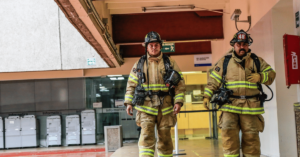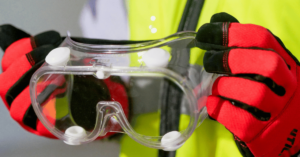In this article, we discuss what a first aider is and employers’ responsibilities for first aiders.
We” also explain how to become a first aider and what qualifications are out there. Finally, we will tackle what qualities an individual needs to succeed as a first aider.
Key Points:
- Anyone can become a first aider, as long as they have the right qualifications and training.
- A first aider is responsible for helping someone who is injured. If further help is on its way, a first aider can monitor the situation and provide care until a professional medic arrives.
- To become a qualified first aider, there are two basic first aid courses available. They are the Emergency First Aid at Work (EFAW) and First Aid at Work (FAW)

What Is A First Aider?
First aiders are a pre-requisite to ensuring a safer working environment.
They provide immediate assistance and care to those who need it, with the intention of preserving life or preventing an injury from getting worse.
Who Can Be One?
Anyone can be a first-aider, as long as they have the right qualifications and training.
What Responsibilities Do First Aiders Have?
A first aider is responsible for helping someone who is injured. If further help is on its way, a first aider can monitor the situation and provide care until a professional medic arrives.
St John’s Ambulance outlines the seven responsibilities of a first aider which are:
- Calmly reviewing the situation
- Protecting the injured person, as well as themselves, from any danger
- Preventing infection between the injured person and themselves
- Comforting the injured person and reassuring them
- Assessing the injured person, and treating those with life-threatening conditions first
- Calling for extra support from the ambulance service
When you’re fully qualified as a first aider, you’ll have a greater understanding of what to do at each stage, to protect as many people as possible.
What Responsibilities Do Employers Have Regarding First Aiders?
It is worth noting that as with all health and safety related decisions, the business/employer needs to understand what circumstances they are asking their employees to work under and what risks are presented to them. This can be done by completing a risk assessment.
A risk assessment helps decide what type of first aid arrangements and training will be required. For example, a small business that is low risk would only need to have the basic arrangements in place, such as a simple first aid box and an appointed person to take charge of calling for help or the emergency services.
The HSE website notes that the appointed first aider does not need to have specific first aid training to undertake this role – just to be made aware of the arrangements that are in place at the workplace.
However, the HSE also says that ‘workplaces where there are more significant health and safety risks are more likely to need a trained first-aider.’
This HSE checklist will help you decide what is best for your business. Here, you will see a series of points to consider which will allow you to make a decision on levels of provision.
Example considerations here are:
#1. Consider your workplace and what type of hazards you could come across
This will be the difference between having a full first aider or just having an appointed person. Most workplaces will have equipment or processes that could cause accidents that would need immediate first aid treatment – the guidance asks if you understand what could happen and then evaluate whether or not the appointed person could deal with that situation, or does it need someone with more in-depth knowledge and training?
For example, industries such as steel fabrication, construction sites, outside broadcasting, and satellite installations all require both types of first aiders.
#2. Factor in how many staff you have and where they are located around the site
For example, do we have younger staff or staff with disabilities that may require specific assistance? Personally, I have experienced working with staff that need regular self-treatment for illnesses such as diabetes, Crohn’s disease or rheumatoid arthritis; all of which require a first aider to have more training.
If not, the appointed (and unqualified) person responsible for first aid could quickly become out of their depth.
#3. Consider non-employees, lone workers, and other working arrangements, such as shift patterns.
It is also important to consider how far away the nearest hospital is.
#4. With regards to accidents in the workplace, consider if anything has happened in the past that may have needed first aid treatment.
If so, does it affect the level or amount of provision required? For example, do you need facilities such as eye showers, additional defibrillators, paediatric training or first person on scene?
*Before making a decision, as an employer you will need to undertake a full risk assessment to understand what level of first aid service or training is needed in the workplace, and the appropriate numbers of first aid staff needed to cover the whole of the business.
How to Become a Qualified First Aider
To become a qualified first aider, there are two initial basic first aid courses available depending on your risk assessment results:
The first level of training is:
- Emergency First Aid at Work (EFAW): On this Level 2 course, you are trained to provide emergency first aid to someone who is injured or becomes ill while at work, for example, dealing with a conscious person who is breathing with minor wounds or injuries, to an unconscious person who is not breathing and needs CPR (Cardio Pulmonary Resuscitation). This is usually a one-day first aid course.
The second level of training is:
- First Aid at Work (FAW) – This Level 3 course enables those with the previous EFAW knowledge and training with extra training to deal with a range of other injuries and illnesses, for example, diabetic emergencies, strokes, different types of shock, etc. The course also goes into more depth and covers more complicated situations that may arise. These courses are usually completed over three days.
How To Improve Yourself As A First Aider
You can always take a refresher training course to improve your knowledge of first aid, and keep key information front of mind.
The one-day FAW course will need to be refreshed regularly. The HSE strongly recommends it be refreshed annually, allowing first aiders to maintain their basic skills and keep up to date with and changes to first aid procedures.
You may decide that neither of these qualifications are fit for your business circumstances, so there are more advanced courses (first responders, medics etc) that are available from the likes of St John and British Red Cross that will tailor the training to the company needs.
What Qualities Make a Good First Aider?
#1. Communication
One of the most important attributes for being a first aider is good communication. As a first aider, you can experience a broad spectrum of incidents, so being able to communicate effectively both to the emergency services and to the injured person will instil trust and reassurance with both.
#2. Ability to Work Under Pressure
You can never say hand on heart that you will be calm and collected when something happens, and that is why we should practice at every opportunity presented to us to make sure that if the worst does happen, we are well-prepared. This will help us become more able to work under pressure.
#3. Initiative
Taking initiative is a great attribute. Remember – everything or everyone around you is potentially something or someone that can help you.
#4. Positivity
It pays to be positive, and it is unlikely an accident you will experience will end in tragedy. Most accidents need a calm head, positive thinking, and those all important first aid skills.








